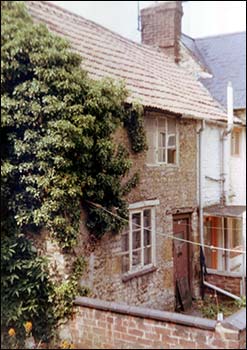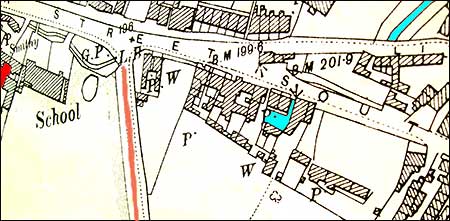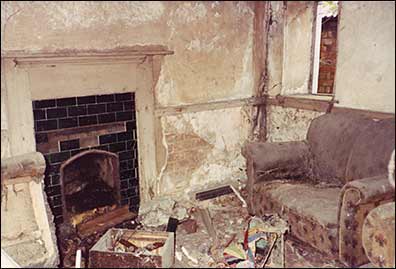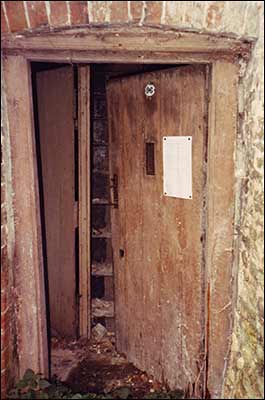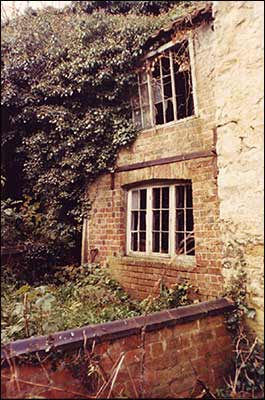|
|||||||||
| Stella Myers 2007 |
|||||||||
|
Memories of 94 High Street South
|
|||||||||
Like many others who were swelling Rushden’s population at that time, they had left the agricultural work of their two small villages of Baston and Langtoft in the Fens to find better paid employment in this booming new industrial town. Despite its small proportions, they brought up five children in the cottage, although the two eldest boys had already left home to go to war before the youngest child, their only daughter, was born. The cottage, measuring only about 12 x 12 feet, consisted of one room downstairs with the front door opening directly onto the yard and a small scullery at the back. Upstairs was a large landing and one bedroom at the front. On the right of the front door was a shallow stone sink with a single cold tap. This had been fitted sometime after the family moved into the cottage: before that they used the communal pump in the yard. Under the window on the left of the door stood a chaise longue and on the adjacent wall to this was the fireplace with its mantelpiece and swivelling trivet for heating the kettle etc. In front of this lay a rag rug. On the opposite wall a chest of drawers supported a large glass case containing a stuffed fox. (Many years later this was presented to Newton Road School). In the centre of the room stood the scrubbed-top table and two wooden bow-backed armchairs, with a single gas lamp hanging above. On the far wall opposite the front door, two doors led to the pantry/scullery and the winder staircase, with a “German Springer” pendulum clock hanging between them, and a third to the cupboard under the stairs. At the top end, facing down the yard on slightly higher ground, stood the barns and coal sheds and in the left hand corner, facing the cottages, the earthen toilets with their wooden seats. The piece of spare ground in front of the barns and behind the toilets was used for storing gardening equipment. Further down the yard on the left of the path was the wash house, containing not only the brick copper in the corner, but also the gas stove. Here the main meals were cooked, which then had to be carried across the open yard to the house in all weathers. On Sundays, as with most other families in the area, the joint of meat was taken in the roasting tin containing the Yorkshire pudding mixture to the nearby baker’s to be cooked in the bread oven. Wash day was quite an event. The water was heated in the copper and then four or five separate tin baths were filled, one with the soapy water, one or two with clear rinsing water, one with “Reckitts Blue” for the whites and yet another containing the starch. In warm, dry weather they would be lined up in the yard, otherwise they would be placed around the walls of the barn. Then the whole wash would have to go through the large cast-iron mangle with its wooden rollers before being hung on the washing line in front of the barns to dry. Mrs. Myers was renowned for the whiteness of her whites and took in washing for the Sartoris family who lived at Rushden Hall, as well as the cassocks worn by the clergy and choir of St Mary’s Church. When the daughter of the house left home to get married in 1939 the families occupying the other dwellings around Upton Place (by this time no. 94 High Street South) were as follows:- The large double-fronted house, which faced the main road on the right of the entry, housed the Glenn family. The smaller bay-windowed house on the left of the entry and slightly set back from the path belonged to a Mrs. Allen, who sold sweets and ice-cream and also served tea to the bus drivers who used to turn their buses in the entrance to Little Street. This house had a back garden, larger than the others in the yard, surrounded by a wall. The gate into it was on the left just past the entry along the path to the cottages. The first of these was occupied by Mr. Sid Bass, a bus conductor, and on the other side of number 94 lived Mr. and Mrs. Brudenell, whose cottage was slightly bigger than the others and boasted an outhouse attached to its far wall. In 1951, following the death of his wife, Mr. Myers moved to go and live with his third son and from then on the cottage stood empty. At least one of the other cottages has housed tenants since that date and the Glenn and Allen houses continued to be occupied for some years afterwards.
|
|||||||||
|
|
|||||||||
